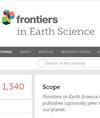Quantitative analysis of crustal deformation, seismic strain, and stress estimation in Iran via earthquake mechanisms
IF 2
3区 地球科学
Q3 GEOSCIENCES, MULTIDISCIPLINARY
引用次数: 0
Abstract
This study investigates the variations in stress, strain, and deformation of the Earth’s crust in Iran arising from tectonic movements and seismic activities. We employed the Kostrov and Molnar methods to quantify these parameters, focusing on the influence of different zoning techniques on the estimations. Analyzing data from 637 earthquakes (moment magnitudes > 5.5) spanning 1909 to 2016, we determined the directions of maximum pressure, tension, and seismic strain through two primary approaches: comprehensive zoning and individual earthquake analysis. Additionally, we assess horizontal shortening and vertical crustal adjustments. Our methodology involves three distinct strategies: individual earthquake analysis, 1° × 1° zoning, and tectonic zoning. The findings demonstrate that the choice of zoning method significantly affects the direction and magnitude of seismic strain estimations. Although both methods identified significant deformations in the Dasht Bayaz and Qaen regions of Eastern Iran, differences between the Kostrov and Molnar methods in estimating seismic strain are observed. The high Zagros region shows signs of crustal thickening, whereas the Zagros foreland exhibits crustal thinning. Intriguingly, Eastern Alborz indicates uplift, and Western Alborz suggests subsidence, offering an alternative view to the conventional tectonic understanding of the Alborz range. These results highlight the critical role of zoning in stress analyses and the disparities between widely used estimation techniques. They underscore the necessity of careful method selection and interpretation in geodynamic studies, particularly in seismically active regions like Iran.通过地震机制对伊朗地壳变形、地震应变和应力估算进行定量分析
本研究调查了伊朗地壳因构造运动和地震活动而产生的应力、应变和变形变化。我们采用 Kostrov 和 Molnar 方法对这些参数进行量化,重点关注不同分区技术对估算结果的影响。我们分析了 1909 年至 2016 年期间 637 次地震(震级为 5.5 级)的数据,通过两种主要方法确定了最大压力、拉力和地震应变的方向:综合分区和单个地震分析。此外,我们还评估了水平缩短和垂直地壳调整。我们的方法包括三种不同的策略:单个地震分析、1° × 1°区划和构造区划。研究结果表明,区划方法的选择对地震应变估计的方向和幅度有很大影响。虽然两种方法都确定了伊朗东部 Dasht Bayaz 和 Qaen 地区的重大变形,但 Kostrov 和 Molnar 方法在估算地震应变方面存在差异。高扎格罗斯地区显示出地壳增厚的迹象,而扎格罗斯前陆则显示出地壳变薄的迹象。耐人寻味的是,东阿尔伯兹地区显示出隆起,而西阿尔伯兹地区则显示出下沉,这与阿尔伯兹山脉的传统构造认识不同。这些结果凸显了分区在应力分析中的关键作用,以及广泛使用的估算技术之间的差异。它们强调了在地球动力学研究中,特别是在伊朗这样的地震活跃地区,谨慎选择和解释方法的必要性。
本文章由计算机程序翻译,如有差异,请以英文原文为准。
求助全文
约1分钟内获得全文
求助全文
来源期刊

Frontiers in Earth Science
Earth and Planetary Sciences-General Earth and Planetary Sciences
CiteScore
3.50
自引率
10.30%
发文量
2076
审稿时长
12 weeks
期刊介绍:
Frontiers in Earth Science is an open-access journal that aims to bring together and publish on a single platform the best research dedicated to our planet.
This platform hosts the rapidly growing and continuously expanding domains in Earth Science, involving the lithosphere (including the geosciences spectrum), the hydrosphere (including marine geosciences and hydrology, complementing the existing Frontiers journal on Marine Science) and the atmosphere (including meteorology and climatology). As such, Frontiers in Earth Science focuses on the countless processes operating within and among the major spheres constituting our planet. In turn, the understanding of these processes provides the theoretical background to better use the available resources and to face the major environmental challenges (including earthquakes, tsunamis, eruptions, floods, landslides, climate changes, extreme meteorological events): this is where interdependent processes meet, requiring a holistic view to better live on and with our planet.
The journal welcomes outstanding contributions in any domain of Earth Science.
The open-access model developed by Frontiers offers a fast, efficient, timely and dynamic alternative to traditional publication formats. The journal has 20 specialty sections at the first tier, each acting as an independent journal with a full editorial board. The traditional peer-review process is adapted to guarantee fairness and efficiency using a thorough paperless process, with real-time author-reviewer-editor interactions, collaborative reviewer mandates to maximize quality, and reviewer disclosure after article acceptance. While maintaining a rigorous peer-review, this system allows for a process whereby accepted articles are published online on average 90 days after submission.
General Commentary articles as well as Book Reviews in Frontiers in Earth Science are only accepted upon invitation.
文献相关原料
| 公司名称 | 产品信息 | 采购帮参考价格 |
|---|
 求助内容:
求助内容: 应助结果提醒方式:
应助结果提醒方式:


